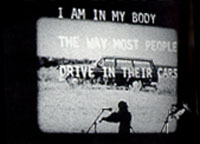


|
I met a painter and he said, "If you wait, the canvas will call to you" He said, "If you speak to it, it will speak to you." All good things are worth their weight And he who hesitates...is late. From "Talking Papers", 1977 |
In the 70's, the center of the New York art world was Soho, and Laurie Anderson was in the middle of it all. "New York in the early 70's was Paris in the 20's," she says (Anderson, 283). Anderson was involved with the artistic group of pioneers that would later be referred to as "Downtown."
The Downtown phenomenon was not so much a unified movement as much as an overall change in attitude towards the nature of art. "Downtown New York artists began to push the limits of traditional categories of art, believing these categories confine artistic expression. Artists were also writers, writers were developing performance pieces, performers were incorporating videos in their work, and every one was in a band" (Fales, index3.html). Artists, sculptors, and musicians worked together to blur the boundaries between the art forms, playing off each other's work in an atmosphere of anarchy, creativity, and chaos.

Laurie Anderson studied printmaking in 1972, and shortly afterwards began her exploration with books. She printed handwritten stories and photographs on onion skin paper, and displayed the book beneath a glass case with two fans installed on either side, which would alternate blowing the pages back and forth - a work constantly in motion. She created a series of 26 booklets based around the alphabet, designed to prove that motion and time do not exist. She created a "Handbook" with a phrase handwritten on each page, designed as a manual for turning pages. She dabbled in illustrations and etchings, sometimes in order to keep food on her table (Anderson, 99).
In the summer of 1974, a thief broke into Anderson's loft, and stole or destroyed nearly all of her possessions. Stricken with grief, she found solace in Albrecht Durer's Melencolia I, using the 16th century engraving to illustrate her list of missing treasures. In Light in August, Laurie Anderson lists the items involved in the 1974 break-in, corresponding each item to an image highlighted in red in a reproduction of Durer's Melencolia I. Things that have been stolen, destroyed, or left behind are assigned a new identity within the framework of the engraving. The original work was displayed in an actual book, with a different image on each page, and its corresponding item beside it.
